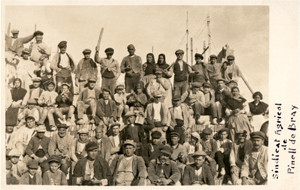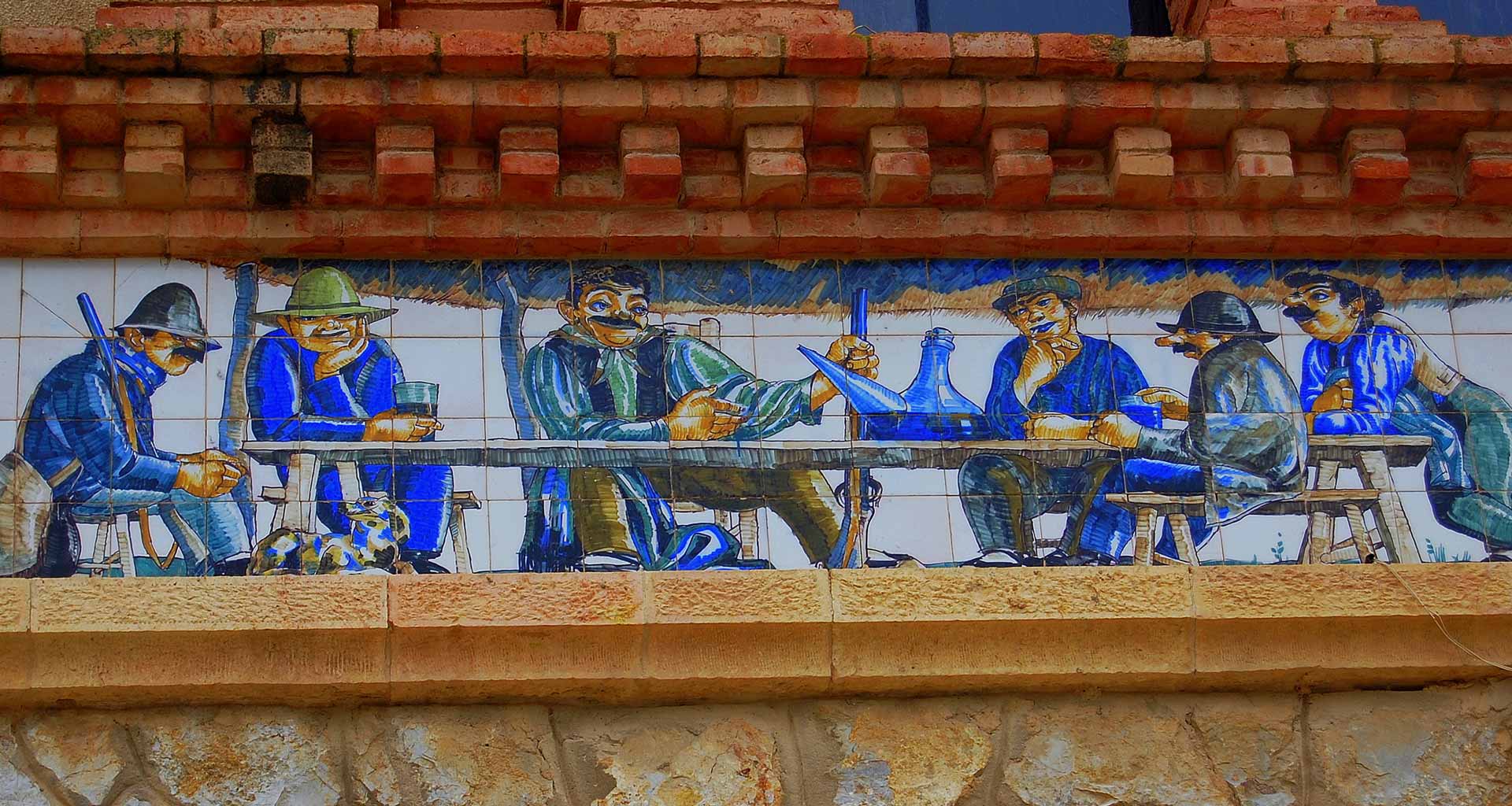The cooperative winery: 100 years

We pay homage to all the farmers, relatives and inhabitants of Pinell de Brai who, at the beginning of the 1900s, felt a need to build a cooperative winery, a flagship of Catalan Noucentisme. People of courage, capable of turning work into an art. People who made what, at the time, was a substantial investment, but left us this most wonderful building as part of our shared human heritage.
Timeline
1928-1922: construction of the Catedral del Vi Cooperative Winery.
1939: explosion and subsidence of a parabolic arch, rebuilt by Melich.
1949: the ceramic work previously hidden was salvaged and used on the main facade.
1962-1964:a new row of tanks was put in along the wall on the right side of the facade.
1988: architectural work to strengthen the structure of the machine shop and refurbishment of the roof
The building is built in traditional modernist style, but the mere fact that it received the official blessing of the Local Community should, in itself, place it within the Noucentist movement. Martinell considered himself a Noucentist, but likewise a disciple, admirer and follower of Gaudí.
The winery comprises three adjoining front facing naves, with two cross naves at the rear of the building, on a different level. The part of the building to the left, on two floors and with a wood overlay roof, was where the oil mill was housed. The central and right hand parts were the vat rooms. The two sections are roofed by balanced parabolic arches. To the rear is the high ceilinged production zone, likewise covered by a rafter truss roof.
The inside of the winery is a large space cross-divided by the parabolic roof-bearing arches. These huge arches boast perforated spandrels to enhance the building’s feeling of lightness and luminosity. The space flows through to the production area, through a large brick latticework section which offers relief to the dividing wall.
The main façade clearly distinguishes the three sections that make up the structure of the winery. At the top there is as series of brickwork openings, creating a magnificent piece of latticework. Each of the sections is crowned with a powerful cornice, decorated at the top with green glazed ceramic work.
A high, painstakingly crafted, masonry socle at the bottom houses the openings for ventilation and also integrates the monumental entrance ways situated at the centre of each of the naves, built from bush hammered stone. Crowning the socle and running from end to end of the over 40 metres of façade, we find a ceramic frieze painted by Xavier Nogués caricaturing the work of the grape and olive harvest and the production of wine and oil. The artist’s collaboration with the decoration of the building makes it of special interest amongst the work of Cèsar Martinell.

Cèsar Martinell i Brunet was amongst the last witnesses of one of the most relevant periods in Catalonia: Noucentisme.
Both in his architecture and historiography, culturally speaking he was a living exponent of a collective movement, the fruit of which remains part of our heritage today.
Martinell was a kind of intellectual bridge between the second generation of masters of the Catalan Renaissance (Antoni Gaudí, Lluís Domènech i Montaner, Puig i Cadafalch, etc. …) and the post-war generation. His architectural and literary work bridges the cultural distance between the turn of the 19th-20th century and the first two thirds of the 20th century and enables us to understand the message and evolution of the most diverse historical, political, social and cultural moments of history.
A multifaceted individual, like many of his contemporaries, Martinell worked hard, not just as an architect, but also as a researcher, communicator and chronicler of the art of his, and earlier times. In him, Eugeni d’Ors found an excellent companion with whom to walk the road to culturalisation upon which the Commonwealth of Catalonia had embarked.
Cèsar Martinell i Brunet was born in Valls, Camp de Tarragona, on December 24, 1888, the year in which Barcelona had the honour of hosting the Universal Exposition.
Camp de Tarragona is a county which has produced a prolific number of outstanding architects and artists: the 19th century also saw the birth of Antoni Gaudí, Francesc Berenguer, Joan Rubió i Bellver and Josep Maria Jujol, all architects who left much admired and respected work to posterity. The sculptor Anselm Nogués and painters Galofre Oller and Jaume Mercadé, the novelist Narcís Oller, the historian Indalecio Castells who initiated Cèsar Martinell in the field of historiography, the photographer Pedro Català Pic and, in the 20th century, the likewise photographer Francisco Català Roca … all were the sons of Valls.
Likewise born in Valls were the excellent practitioners of the Baroque architecture and sculpture of the 17th and 18th century, Brother Josep de la Concepció and Lluís Bonifàs i Massó, whom Martinell studied and whose art work he brought to the attention of the public.
On his father’s side, Martinell came from a family of dyers while, on his mother’s, a family of master builders , a determinant influence in his vocation for architecture. He started his university studies in Barcelona in 1906. At the School of Architects, amongst others, he was taught by Lluís Domènech i Montaner and August Font i Carreras, while at Francesc d’A. Galí Art School, he learnt to draw alongside Joan Miró, Manuel Humbert and Jaume Mercadé.
Just before qualifying, Martinell started work at the studio of Joan Rubió and, at the same time, to form part of the circle of architects that surrounded Gaudí at the beginning of his retreat to the Sagrada Família Church. His relationship with the master gave rise, on the one hand, to a special way of understanding and developing architecture and, on the other, to a direction of research which steadfastly sowed the seeds of Gaudinism.
He completed his studies in 1916. For his final project he developed a Ministry of Public Instruction and Fine Arts that, for its very public nature, had to be a monumental structure. The style was what could be called the “Barcelona School of Architecture” Style, what year after year was demanded of the students, with conceptual approaches and a use of space and functions similar to those of the Elías Rogent Literary University, built fifty years previously, or Enric Sagnier’s Courts of Justice, built twenty-five years earlier, or, even more to the point, the building designed for the Provincial Authorities of Public Instruction by the architects Lluís Domènech i Montaner and Josep Vilaseca in 1877. Likewise, the final degree projects of Rubió i Bellver and Rafael Masó, followed similar paths.
The diversity of teachings and influences received by Martinell (on the one hand, from the masters of Modernism and, on the other, those filling the waiting room of the then burgeoning Noucentista Movement) was decisive in forming his personality which, by force, had to be multi-faceted. In a way, one could say it had to encompass an attitude which combined universality and eccentricity (in the sense of escaping from the poverty of specialising in any one single area). And, it had to produce work that would serve as a bridge, a transition, between the different aesthetic currents.
The variety of the architecture drafted by Martinell reveals this aesthetic diversity.
While his agricultural architecture reveals, in principle, the direct influence of the two great Catalan Modernist architects: Gaudi in terms of the treatment of space and Domenech in terms of form and material, his public architecture was impregnated with Noucentist values (classicism and simplicity of line) while his domestic architecture showed the influence of the passing fashions: monumentalism, a certain kind of rationalism, “Casticism” …
On the other hand, his work in the area of religious architecture and restoration could be classified as part of what certain authors have called the “conservative school”, one of the main theoretical proponents of which was the architect Josep Puig i Cadafalch.

Xavier Nogués: Catalan painter, engraver and illustrator. One of the most representative artists of Noucentisme, his work is inspired by the traditions of Catalan popular art. He started his career drawing satirical illustrations for different publications. He began engraving in 1909 and illustrated works such as “La ben plantada” by Eugeni d’Ors, or “Catalunya pintoresca”,” L’abecedari catalá i el Bestiari”, by P. Quart. Between 1904 and 1940 he painted 65 oil paintings, mostly of small size, on popular subjects and in a Naïve style. He was commissioned to paint the murals for the cellars of Galeries Laietanes, Casa de Plandiura (la Garriga) and the Agricultural Union of Pinell de Brai.
Jaume Ciurana



